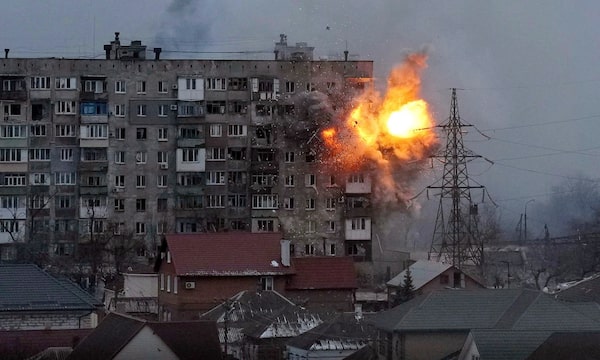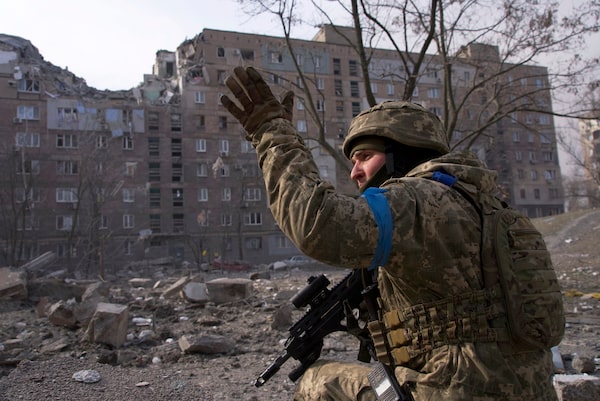
An explosion erupts from an apartment building after a Russian army tank fired on it in Mariupol, Ukraine, on March 11, 2022.Evgeniy Maloletka/The Associated Press
Russia’s military assault on the city of Mariupol in the early days of its war on Ukraine left thousands of civilians dead or injured, and many trapped and cowering in basements for weeks without access to basic services, according to a new analysis.
A report published Thursday by Human Rights Watch, in partnership with the Ukrainian human rights organization Truth Hounds and SITU Research, a New York-based organization that performs visual investigations, documents the devastation Russian forces inflicted on Mariupol between February and May, 2022. It calls for Russian President Vladimir Putin and senior Russian officials to be investigated and prosecuted for their roles in apparent war crimes committed by Russian forces.
Over the course of nearly two years, researchers conducted 240 interviews, most of them with displaced Mariupol residents, and analyzed more than 850 photos and videos, as well as documents and dozens of satellite images. It is difficult or impossible for Western organizations to observe the war’s toll on Mariupol directly, because Russia took full control of the city in May, 2022.
Russian forces encircled the city, forcing civilians to hide in basements for up to seven weeks in horrifying conditions, the report says. It describes residents sheltering without running water, heat, electricity or information about what was going on in their city or the war. The report documents cases where people risked their lives or were killed trying to retrieve water from wells or distribution trucks.
The report also documents the many unsuccessful attempts made by Ukrainian officials, the United Nations and the Red Cross to facilitate evacuations and the delivery of humanitarian aid.
Ida Sawyer, the director of Human Rights Watch’s crisis and conflict division and an author of the report, said the group’s work focused on the city centre. The research found that more than 4,800 buildings there were damaged or destroyed, including 93 per cent of the area’s 477 high-rise apartment buildings. All 19 of the city’s hospitals were damaged or destroyed, she said, and 86 of 89 schools were also damaged. Ms. Sawyer said damage to electricity and water infrastructure left civilians sheltering in dire straits.
“People just describe this as a hell on earth,” she said.
Ms. Sawyer said a goal of the project is to demonstrate the impact of Russian use of weapons in populated areas, such as tank shells, heavy artillery, multi-barrel rocket launchers and missiles. She said the researchers are urging more countries to sign a 2022 international political declaration on curbing the use of explosive weapons in populated areas. The declaration has already been endorsed by dozens of countries, including Canada.
The researchers produced 14 case studies covering 18 locations, many of which involve apparently unlawful Russian attacks, including assaults on two hospitals, the city’s famous drama theatre, a food storage facility, an aid distribution site, a supermarket and residential buildings. In some cases, researchers didn’t find evidence of Ukrainian military presence, which would make these attacks unlawfully indiscriminate. In other cases, they found a limited military presence, which would likely make the attacks unlawfully disproportionate, the report says.

A Ukrainian serviceman guards his position in Mariupol, Ukraine, March 12, 2022.Mstyslav Chernov/The Associated Press
The researchers analyzed satellite imagery, photos and videos of the city’s main cemeteries and found that more than 10,000 people were buried in Mariupol between March, 2022 and February, 2023.
They compared the growth in the number of graves with the city’s regular mortality rate and estimated that at least 8,000 people had died from fighting or causes related to the war. But, the report says, the number of dead may be significantly higher.
The researchers said that as more of the city fell under Russian control, many residents who wanted to flee to Ukrainian-controlled territory were instead forced to go to Russia or Russian-occupied territories. The forcible transfer of civilians outside of their home territory is a violation of international law and may amount to a war crime, the report adds. Thousands of children from Mariupol were among those who were forcibly transferred.
The researchers identified 17 units of Russian and Russia-affiliated forces that were operating in the city in March and April, 2022, and 10 individuals who may be responsible for war crimes. The report says the 10 people and potentially others should be investigated and prosecuted for their alleged roles in serious violations committed during the Russian forces’ assault.
People walk past a residential building heavily damaged during Ukraine-Russia conflict in the southern port city of Mariupol, Ukraine May 20, 2022.ALEXANDER ERMOCHENKO/Reuters
“Concerted international efforts towards justice and accountability are crucial to demonstrate that unlawful attacks carry consequences, to deter future atrocities, and to reinforce the principle that accountability for grave crimes cannot be eluded because of rank or position,” the report says.
Russian forces have started building new high-rise apartments, as part of Russia’s reconstruction plan. The report says an occupying power should clear debris and demolish unsafe structures to protect people. But, it adds, without independent investigators the Russian government is erasing physical evidence at hundreds of potential crime scenes.
It also appears, the report says, that residents can only benefit from the reconstruction efforts if they show support for occupying forces. It says occupying Russian forces are stripping away Ukrainian identity by enforcing a Russian school curriculum and renaming streets, and are also making residents obtain Russian passports to apply for jobs and benefits.
The researchers say the destruction of evidence makes the digital damage assessment even more necessary.
“What we heard again and again from people we interviewed is that they want to see justice, they want those responsible to pay a price, they want reparations to be paid to victims and their family members,” Ms. Sawyer said.
 Janice Dickson
Janice Dickson